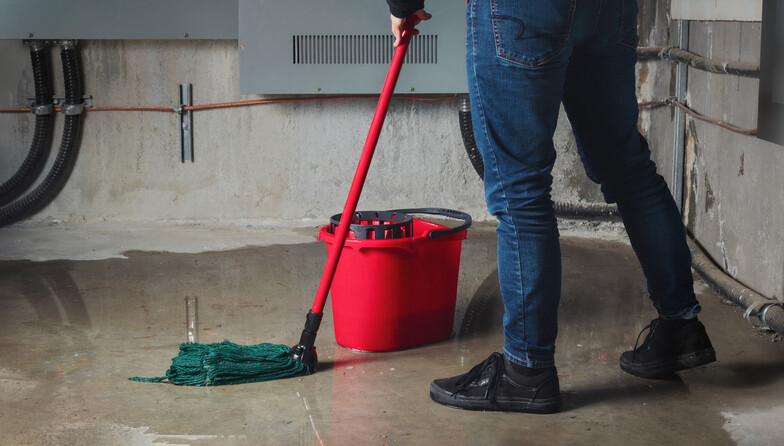 They call them April showers for a reason - the arrival of spring and the possibility of extra rainfall means that now is a good time to consider the possibility of water damage, especially for lower-level areas such as cellars, car parks and basements. It’s crucial to not only have a plan in place to prevent flooding, but also an understanding of the clean up and restoration work that will be required should water damage occur. Read on to find out more.
They call them April showers for a reason - the arrival of spring and the possibility of extra rainfall means that now is a good time to consider the possibility of water damage, especially for lower-level areas such as cellars, car parks and basements. It’s crucial to not only have a plan in place to prevent flooding, but also an understanding of the clean up and restoration work that will be required should water damage occur. Read on to find out more.
Having a flood plan for your basement
Basements are great for providing your house with extra space. They can be used for storage or even as a separate living area to enjoy hobbies such as music. However, if a basement is improperly sealed or if a pipe leaks, it can become damp or flooded, potentially ruining everything that’s been touched by the water.
This is why it is important to have a plan to prevent your basement from flooding by taking some precautions. If the basement is already flooded then it is important to act fast. The water must be pumped out and everything must be dried as quickly as possible to avoid further damage. In this article we’ll go over the steps that should be taken in case a basement floods and the equipment that can be used to help in this process. At Drogheda Hire and Sales we offer a variety of pumps, fans, dehumidifiers and other tools and equipment to restore a water damaged basement.
Pumping out the water
The first and most important step to take in case of a flooded basement is to pump out the water. This means that a designated area for the disposal of water has to be found, which could be the general drains, depending on local regulations. A pump has to be set up with the discharge hose (usually a flat hose) taking the water to that location, ensuring that the hose has no folds that could block the flow of water. There are different types of pumps that can be used for this process:
- Trash pumps: These pumps are designed to move large volumes of water with debris and are usually used to pump water out of ponds. They use a suction hose with a strainer that goes into the water and a discharge hose to move the water to the desired location.
Most notable amongst trash pumps are the Wacker Neuson pumps, such as the Wacker Neuson PT2 and the PT3 petrol models, the latter having a 3 inch outlet and able to handle solid material of up to 1.5 inches in diameter. This is ideal for a basement cleanup project since it uses a petrol engine, ideal when electricity is not available, and will pump water surprisingly fast. It will also be able to handle small objects that may be in the water.
- Submersible pumps: Submersible water pumps, unlike trash pumps, are not designed to handle debris. They can handle some fine particulates however and are ideal for pumping water out of a basement.
The TSURUMI HS2.4S electric sub pump for example has a 2 inch outlet, and will pump water very quickly. As the name suggests the pump is meant to be submerged in water to work, and cannot be allowed to run dry.
- Puddle pumps: These are possibly the best option for most cases of basement flooding, and even when other pumps are used, they are most likely to be needed to remove the remaining water.
Puddle pumps like the TSURUMI LSC are submersible pumps that can pump water down to a very low level. By moving them around different areas of the basement, it is possible to remove most if not all of the water.
Drying and cleaning
Once the water is pumped out of the basement it is essential to start drying right away. First windows and doors should be opened if there are any, and fans should be set up around the room. One or more large dehumidifiers like the DRI EAZ BD1000 will also be necessary, especially if the intention is to recover some of the wet material.
This is also the time to look for the cause of flooding as well as remove wet plasterboard, insulation and flooring. Depending on how much water has gotten into the basement and how much needs to be disposed of it may be necessary to hire a skip. It is important to note that if the basement has flooded due to flooding in the general area it is likely that the water is contaminated, so anything that has been in contact with that water should be disposed of.
Once the studs behind the plasterboard and other wooden structural components are dry it is time to start treating them for mould and bacteria. This step is particularly important since the raised levels of humidity will cause any mould spores in the wood to grow, which could become a serious problem if not dealt with right away.
Finding the cause of flooding and restoring the basement
Once the water has been pumped out of the basement and the drying process is in place it is time to find the cause of the flooding. Water can come from a number of sources, including:
- A leak in a wall that allows rainwater to pass through.
- Bad drainage around the house.
- A clogged drain.
If the basement is old it might require waterproofing, or the existing waterproofing might need to be replaced. Sump pumps can be added to basements. They rely on a drainage system around the inside of the basement that takes water to a sump basin where the pump is kept. They will be activated once the water reaches a certain level in the sump basin. New flooring should be installed as will new insulation and plasterboard.
Choose Drogheda Hire and Sales for water pump and dehumidifier hire
At Drogheda Hire and Sales, we stock submersible pumps, puddle pumps and trash pumps for emptying flooded basements, gardens, pools, skips and a number of other applications. If you would like to speak to us about hiring or buying any of our equipment for your project, don't hesitate to get in touch; we'll be more than happy to assist you.
Call us on 041 9841419 for our Drogheda depot or on 01 9108757 for our Dublin depot, use our contact form or try our Enquiry Bot at the bottom left hand corner of our home page.
